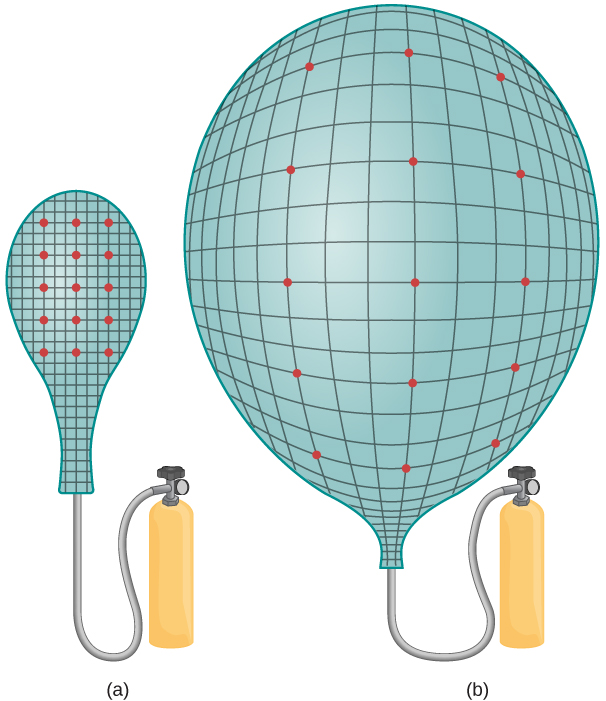| << Chapter < Page | Chapter >> Page > |
Scientists often explain the Big Bang expansion using an inflated-balloon model ( [link] ). Dots marked on the surface of the balloon represent galaxies, and the balloon skin represents four-dimensional space-time ( Relativity ). As the balloon is inflated, every dot “sees” the other dots moving away. This model yields two insights. First, the expansion is observed by all observers in the universe, no matter where they are located. The “center of expansion” does not exist, so Earth does not reside at the “privileged” center of the expansion (see [link] ).

Second, as mentioned already, the Big Bang expansion is due to the expansion of space, not the increased separation of galaxies in ordinary (static) three-dimensional space. This cosmological expansion affects all things: dust, stars, planets, and even light. Thus, the wavelength of light emitted by distant galaxies is “stretched” out. This makes the light appear “redder” (lower energy) to the observer—a phenomenon called cosmological redshift . Cosmological redshift is measurable only for galaxies farther away than 50 million light-years.
This value indicates a galaxy moving close to the speed of light. Using the relativistic redshift formula (given in Relativity ), determine (a) How fast is the galaxy receding with respect to Earth? (b) How far away is the galaxy?
Check Your Understanding The light of a galaxy that moves away from us is “redshifted.” What occurs to the light of a galaxy that moves toward us?
blueshifted
View this video to learn more about the cosmological expansion.
At large scales, the universe is believed to be both isotropic and homogeneous. The universe is believed to isotropic because it appears to be the same in all directions, and homogeneous because it appears to be the same in all places. A universe that is isotropic and homogeneous is said to be smooth. The assumption of a smooth universe is supported by the Automated Plate Measurement Galaxy Survey conducted in the 1980s and 1900s ( [link] ). However, even before these data were collected, the assumption of a smooth universe was used by theorists to simplify models of the expansion of the universe. This assumption of a smooth universe is sometimes called the cosmological principle .

Notification Switch
Would you like to follow the 'University physics volume 3' conversation and receive update notifications?